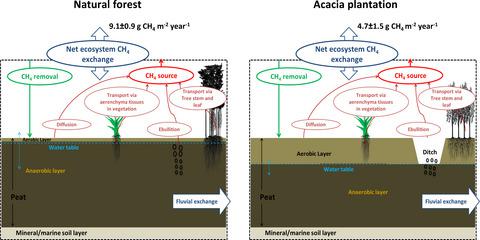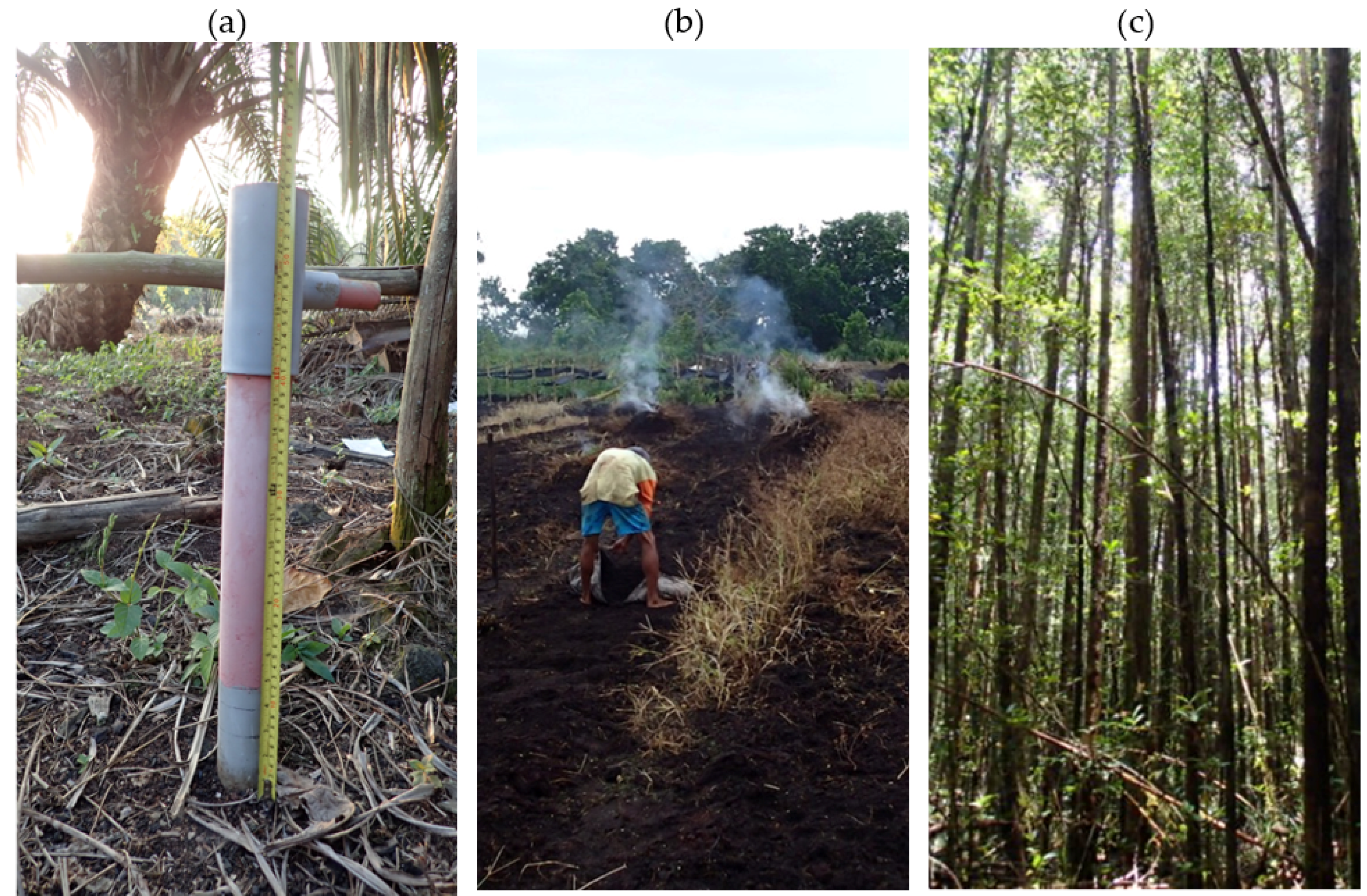In their natural state ombrotrophic peat swamp forests. In conclusion RS was lower and CH4 emission was higher in the undrained peat swamp forest than those previously reported for drained and disturbed forests on tropical peat.

Pdf Impact Of Forest Plantation On Methane Emissions From Tropical Peatland
Tropical peatlands are a known source of methane CH 4 to the atmosphere but their contribution to atmospheric CH 4 is poorly constrained.

Impact of forest plantation on methane emissions from tropical peatland. He is interested in the biogeochemistry of carbon-dense terrestrial ecosystems such as forests wetlands peatlands and forested wetlands and peatlands. The CH 4 emission from the tropical peat swamp forest potentially offset the CO 2 sequestration by the ecosystem in which 50 offset occurred in the relatively disturbed peat swamp forest. The tropical peat swamp forests of SouthEast Asia are being rapidly converted to agricultural plantations of oil palm and Acacia creating a significant global hotspot for CO 2 emissions.
The orders of magnitude of the reduction of the tropical forest methane removals that we observed suggest that deforestation may be contributing between 4 and 9 of this increase. Page Vincent Gauci Ari Laurén Supiandi Sabiham Fahmuddin Agus Adibtya Asyhari Sofyan Kurnianto Yogi Suardiwerianto Ankur R. Soil CO 2 emissions from tropical peatlands drained for croplands and plantations are so high Table 1 that their successful rewetting results in virtually instant climate cooling Figure 2.
CD Gauci V 2017 Management effects on greenhouse. This effect of land-use change is not integrated into global modeling studies and may account for some of the year-to-year variability in atmospheric methane accumulation. Over 50 of tropical peatlands are found in South East Asia of which almost 50 were drained and deforested by 2006 Hooijer et al.
More ecosystem-scale measurements are needed to fully evaluate the effect of land-cover change on. Co-author Impact of forest plantation on methane emissions from tropical peatland Global Change Biology. To understand the effect of compaction on soil carbon dioxide CO2 and methane CH4 flux from tropical peatland a laboratory soil column incubation was conducted.
Observations showed a clear diurnal variation in CH 4 exchange over the natural forest where the GWL was higher than 40 cm below the ground surface. Annual CH 4 exchanges over the natural forest 91 09 g CH 4 m 2 year 1 were around twice as high as those of the Acacia plantation 47 15 g CH 4 m 2 year 1. Our data indicate that the Acacia plantation on tropical peatland results in significant reductions in CH 4 emissions compared to the natural system although the associated cooling impact is likely to be smaller than the accompanying warming impact of higher CO 2 and nitrous oxide emissions.
However the effect of this major perturbation has yet to be quantified in terms of global warming potential GWP and the Earths radiative budget. To evaluate the impact of forest transition to plantations on soil methane CH4 and respiration CO2 fluxes we conducted measurements in an undisturbed forest a disturbed forest young and. S Suardiwerianto Y Desai AR 2020 Impact of forest plantation on methane emissions from tropical peatland Global Change.
Since the 1980s extensive areas of the peatlands in Southeast Asia have experienced land-cover change to smallholder agriculture and forest plantations. Methane balances of tropical peat ecosystems in Sarawak Malaysia. Our results show that tropical peatlands probably have a greater impact on global atmospheric methane concentrations than previously thought he said.
This study investigates the factors controlling the soil CO2 and CH4 fluxes and quantifies annual cumulative soil respiration RS heterotrophic respirati. Desai Impact of forest plantation on methane emissions from tropical peatland Global Change Biology 101111gcb15019 26 4 2477-2495 2020. We found that the annual methane emissions from the natural forest were around twice as high as those of the acacia plantation.
Professor Susan Page of the University of Leicester one of the co-authors of the study said. 014 g cm3 018 g cm3 and 022 g cm3. Methane emission rates appreciably decreased in the oil palm plantation because of alleviated gas diffusion limitation caused by better aeration as a result of lowering of the peat water table layer after drainage effectively converting the former peatlands into a methane sink Melling et al.
Tropical peatlands are a known source of methane CH4 to the atmosphere but their contribution to atmospheric CH4 is poorly constrained. Results highlight that tropical peatlands are significant CH 4 sources and probably have a greater impact on global atmospheric CH 4 concentrations than previously thought. Conversion of a peat swamp forest to an oil palm plantation decreases CH 4 emissions because the land conversion accompanies drainage.
Evans undefined Nardi Ari P. Replacement of forest by agricultural systems is a major factor accelerating the emissions of greenhouse gases. Deshmukh Dony Julius Chris D.
Since the 1980s extensive areas of the peatlands in Southeast Asia have experienced landcover change to smallholder agriculture and forest plantations. Results highlight that tropical peatlands are significant CH 4 sources and probably have a greater impact on global atmospheric CH 4 concentrations than previously thought. The ability of peatland rewetting to mitigate climate change during the next decades depends strongly on the climate zone and current land use.
Conversion of tropical peatland into oil palm plantation in Southeast Asia has been alleged to have increased the decomposition process via peat oxidation due to drainage and water management raising the emission. However related field studies in the tropics are very scarce. 83 of Southeastern Asian peatlands are in Indonesia where oil palm plantation development is a key driver behind the conversion of peat swamp forests Page et al.
Flood modeling prediction and mitigation. Peat soil collected from a Mixed Peat Swamp forest were packed in polyvinyl chloride pipes to three different soil bulk densities BD. This land-cover change generally involves lowering.

World S Largest Tropical Peatland Subsidence Study Published April Dialog

Conceptual Model Summarizing The Effects Of The Conversion Of A Download Scientific Diagram

Greenhouse Gas Emissions Resulting From Conversion Of Peat Swamp Forest To Oil Palm Plantation Nature Communications

Impact Of Forest Plantation On Methane Emissions From Tropical Peatland Global Change Biology X Mol

App To Clear Plantations To Restore Peatlands

Forests Free Full Text The Use Of Subsidence To Estimate Carbon Loss From Deforested And Drained Tropical Peatlands In Indonesia Html

Palm Oil S Climate Impact Worse Than Thought Due To Methane Emissions Environmental Science Save Planet Earth Conservation

Degradation Of Southeast Asian Tropical Peatlands And Integrated Strategies For Their Better Management And Restoration Mishra Journal Of Applied Ecology Wiley Online Library

Peatland Plantations Drive Steep Ghg Emissions In Indonesia S Riau Province

0 comments:
Post a Comment